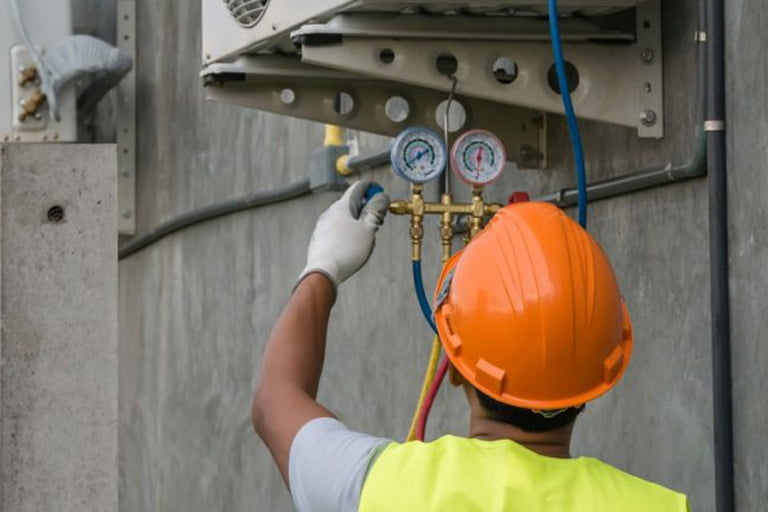What is HVAC?
The Heating, Ventilation and Air-Conditioning (HVAC) industry are companies mainly engaged in the installation, repair and continued maintenance of heating, ventilation, air-conditioning and refrigeration systems. The industry operates on three levels; residential HVAC, commercial HVAC, and industrial HVAC.
The May 2020 National Occupational Employment and Wage Estimates for the United States, created by The Bureau of Labor Statistics, has the number of Heating, Air Conditioning, and Refrigeration Mechanics and Installers as 344,020 ¹, however, these figures don’t include self-employed workers, so the real numbers are much higher.
HVAC Lone Working in North America
According to ibisworld.com there are over 118,000 HVAC companies registered in the U.S at present. ² The states with the highest employment numbers in HVAC are Florida – 33,210, California – 32,410 and Texas – 28,010.³ The 2020 statistics for Canada showed 25,674 HVAC companies ⁴ registered across the country employing over 61,000 people⁵, with the highest concentration in Ontario.⁶ These figures show that there are hundreds of thousands of people working in HVAC throughout North America.
HVAC Lone Working in the United Kingdom
Although the population sizes differ hugely, this is a field that is also well represented in the United Kingdom. The 2019 figures from Statista.com show there were just over 37,000 HVAC companies active in the UK.⁷ The Office for National Statistics January 2022 figures show there were 140,800 people employed as HVAC engineers across Britain mainly concentrated in the South-East of England.⁸
Lone Worker Legislation for HVAC Workers
Under the legislation of the United States, Canada and the United Kingdom all companies with lone workers are required to have a communications system in place. Companies need to have frequent verbal confirmation that lone workers are safe. The HSE (U.K), OSHA (U.S) and CCOHS (Canada) recommend the implementation of employee monitoring procedures that include check-ins at pre-agreed intervals with workers. (For more detailed legislation read: OSHA Regulations 1915, 1910 and 1926 for Lone Working HVAC Technicians)
How Ok Alone Can Help HVAC Technicians and Engineers
Ok Alone, the lone worker safety monitoring app allows workers to check in at regular intervals and request help if they need it. The system has GPS capabilities that can locate a worker if they are out on a job and fail to check-in. Using Ok Alone means that someone who can send help will be notified if a worker doesn’t check-in or requests immediate assistance.
HVAC and the High Risk Feature
Other features of Ok Alone include the ‘High Risk’ function where workers can change the frequency of their check-in depending on their circumstances. The check-in can be set to every 10 minutes if required. Using this feature also alerts the worker’s company that they are entering an area they do not feel safe in. This function allows the worker to inform their company of their new situation without having to phone in.
HVAC and the Man Down Function
The ‘Man Down’ (worker down) function notifies a worker’s office if there has been no movement within a set amount of time (3 minutes – 1 hour). If no movement is detected the phone will sound an alarm alerting the worker that there has been no movement. If this alert is not responded to by the worker, it will be escalated to the worker’s allocated monitor and they will contact the worker. The helpful reminder/alarm to the worker first means there will be less false alarms sent to either the monitor or the call centre.
For a free trial of the Ok Alone lone worker solution go to free trial page.
1 – https://www.bls.gov/oes/current/oes499021.htm
3 – https://www.bls.gov/oes/2020/may/oes499021.htm
6 – https://www.ic.gc.ca/app/scr/app/cis/businesses-entreprises/23822
7 – https://www.statista.com/statistics/1228145/plumbing-and-hvac-company-number-in-great-britain/
8 – https://www.ons.gov.uk/

As an expert in lone worker content management, I possess an extensive knowledge base and experience in the area of lone working and safety monitoring. My expertise in this field encompasses a wide range of areas, including risk assessment, training, communication, and technology. I have a deep understanding of the unique risks associated with lone workers and have researched and written many projects and articles to educate people in how to mitigate these risks.
Throughout my time with Ok Alone, I have kept up to date with technological developments, legislative changes and regulations that have been introduced to help organizations ensure the safety of their lone workers.

